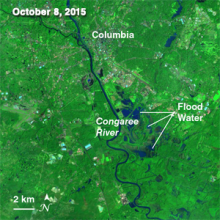- Home
- Missions
- Data
- Communications
- People
- The Earth Observer Newsletter




Recent Imagery
You will be directed to the NASA Visible Earth webpage when you select Images by Mission below, or click on the images at right that are randomly generated to represent four out of all possible topics.
Featured Content
 |
NASA Science Program Support Office 2016 Annual ReportThe Science Program Support Office (SPSO) supported 25 domestic and international science conferences and public events in FY2016. The SPSO strives to provide an inspiring and interactive venue for every event during the year, using a unique storytelling approach that allows a variety of audiences worldwide to connect with NASA Science. The 2016 Annual Report provides a broad overview of these activities, along with details about new Hyperwall stories, publications, social media, key partnerships, and more! |
 |
Orchestrating NASA’s Fleet of Earth Observing SatellitesNASA’s current satellite fleet includes 20 Earth-observing missions. While each satellite performs independent mission work, some augment their science capabilities by flying in close, coordinated proximity to one another as part of a constellation—e.g., the Afternoon Constellation, or “A-Train.” Maintaining the orbits of each of these missions and keeping them all safely operating presents daily challenges. On page 4 of the March-April issue of The Earth Observer, we provide an overview of NASA’s Earth Science Mission Operations (ESMO) Project. |
 |
Learn about NASA's CYGNSS Mission!This brochure provides an overview of NASA's Cyclone Global Navigation Satellite System (CYGNSS) mission--NASA’s first satellite mission to measure surface winds in the inner core of tropical cyclones, including regions beneath the eyewall and intense inner rainbands that could not previously be measured from space. These measurements will help scientists obtain a better understanding of what causes variations in tropical cyclone intensity, helping to improve our ability to forecast tropical cyclones such as Hurricane Katrina. |
 |
Join NASA for Earth DayJoin NASA at Union Station in Washington, DC to celebrate Earth Day, April 21-22, 2016. |
 |
EO-1 Celebrates 15 YearsOriginally planned as a “one-year mission,” NASA’s Earth Observing-1 (EO-1) satellite celebrated the fifteenth anniversary of its launch on November 21, 2015. EO-1 was originally a technology testbed satel- lite, built quickly and inexpensively. EO-1 is finally heading for the end of its mission, which is pro- jected for October 2016. While the platform and its instruments are operating well, fuel reserves have been exhausted and the satellite has lost its orbital maintenance ability. The impressive milestone of reaching its 15-year anniversary, coupled with the impending end of the mission, provides an excellent time to review EO-1’s origins and goals, its expanded mission, and the utility of the data acquired so far. |
 |
Visit NASA at the 2015 AGU Fall MeetingPlease plan to visit the NASA booth (# 335) during the American Geophysical Union’s (AGU) forty-eighth annual Fall Meeting! This year’s exhibit hall will open on Monday, December 14, and will continue through Friday, December 18. This daily agenda provides presentation times for Hyperwall talks as well as In Booth Science Flash Talks. Scientists will cover a diverse range of topics including Earth science, planetary science, and heliophysics. The exhibit will also feature a wide range of science demonstrations, printed material, and tutorials on various data tools and services. We hope to see you in San Francisco! |
 |
2015: Looking Back and Looking AheadFor NASA’s Earth Science Division, 2015 began with three successful launches—CATS to the ISS to study clouds and aerosols, SMAP to study soil moisture and freeze-thaw state from space, and NOAA’s DSCOVR mission, which includes two NASA Earth Science instruments now transmitting data from the Lagrange point 1 (L1). The Nov-Dec issue of The Earth Observer provides the latest updates on data products, milestones reached, and upcoming missions. The cover photo is a tribute to NASA’s Earth Observing-1 (EO-1) mission, which celebrated its fifteenth anniversary on November 21. The image at left shows the interior of South Carolina on October 8, 2015, as observed by the Advanced Land Imager (ALI) on NASA’s Earth Observing-1 (EO-1) satellite. Floodwater covered broad swaths of farmland, forests, and wetlands east of the Congaree River. |
 |
2016 NASA Science Calendar Now AvailableThe 2016 NASA Science Mission Directorate (SMD) calendar is now available. This year’s calendar provides a new look at Pluto, Earth and the moon, global rainfall, our sun, dwarf planet Ceres, a stellar nursery, and more! Reveal a new image with accompanying captions each month. |
 |
COP-21 Hyperwall Science StoriesThe twenty-first Conference of Parties (COP-21) to the United Nations Framework Convention on Climate Change will take place in Paris, France, November 30 to December 11, 2016. Each year, the COP meets for two weeks to discuss the state of Earth’s climate and how best to deal with future climate change. Hosted by the U.S. Department of State, the U.S. Center at COP is a major public outreach initiative to inform attendees about key climate initiatives and scientific research taking place in the U.S. As has been the standard for several years, NASA’s Hyperwall will be set up inside the U.S. Center. This brochure contains most of the science stories that will be shown on the Hyperwall at COP-21 grouped by theme. |
 |
SAGE III on the International Space StationNASA’s Stratospheric Aerosol and Gas Experiment (SAGE) family of remote-sensing-satellite instruments has long measured ozone (O3) concentrations, stratospheric aerosols, water vapor, and other trace gases that influence Earth’s atmosphere. Planned for launch in 2016, SAGE III on the International Space Station will continue the legacy of accurate SAGE measurements. This brochure provides details about the instrument, launch and installation, ground system and data, and more! |
